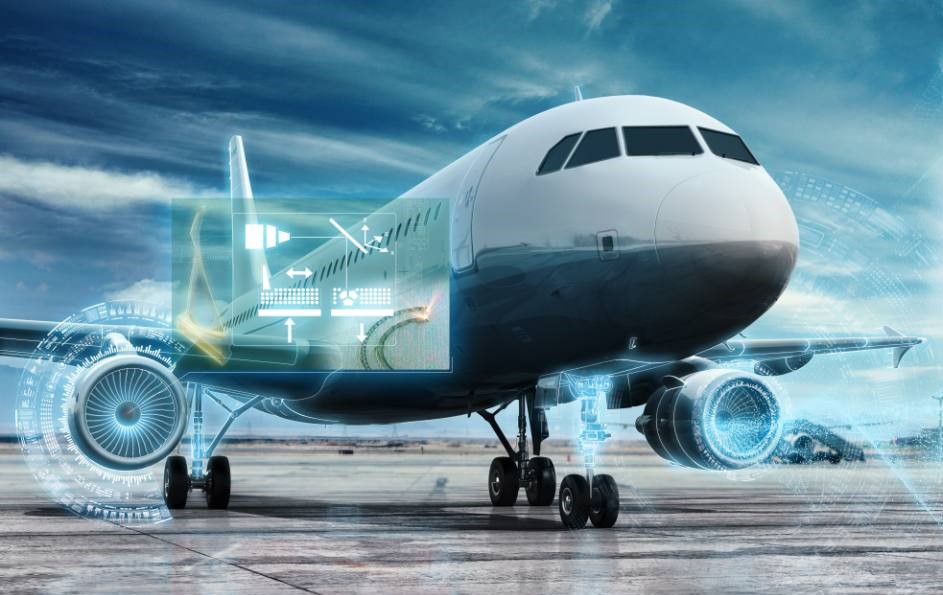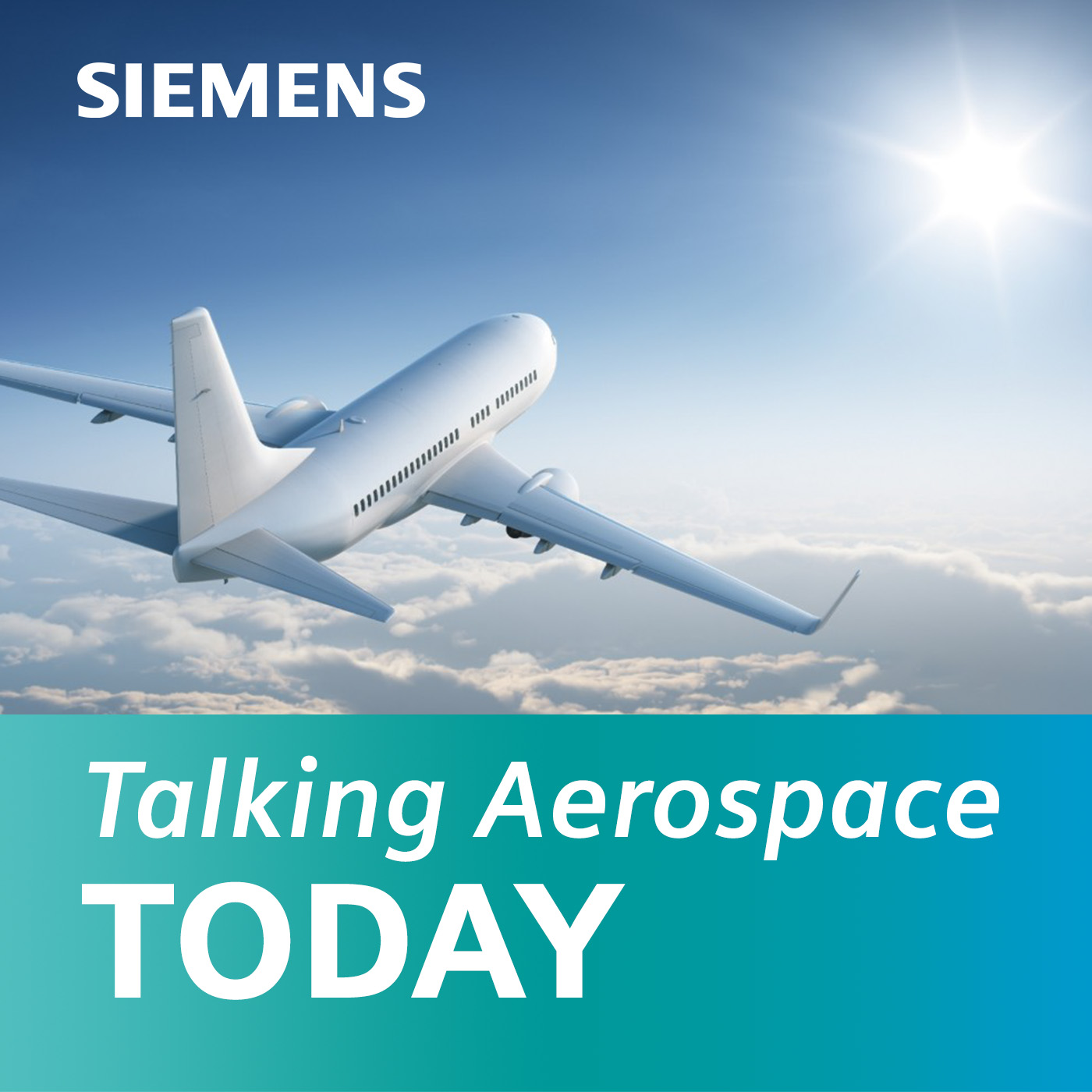“Productivity” podcast series (Ep. #1): What is productivity in this age of digital transformation?

What is productivity in the age of digital transformation? …How are today’s trends impacting productivity? …And what can A&D companies do to usher in a new era of productivity? To answer these questions let’s take a look at the trends shaping the industry.
Dale Tutt and Scott Salzwedel from the Siemens A&D podcast Talking Aerospace Today present a new series on productivity – “Accelerating Productivity through Digital Transformation.”
This is episode #1 in a five-part series.
Welcome to Talking Aerospace Today – a podcast for the Aerospace and Defense industry – the place that brings the promise of tomorrow’s technology to the ears of our listeners today.
We’re in a period of a lot of innovation and in order to survive and even thrive, companies will need to find rapid solutions to get to market faster than their competition. They have to be flexible, productive, and efficient in finding new ways to reach their goals – and the growing complexity doesn’t make their task easier.
Today, in our first episode of the series Accelerating Productivity Through Digital Transformation, we’re introducing the idea of what productivity is in this age of digital transformation, the trends that are hampering productivity, and what A&D companies can do right now to usher in a new era of productivity.
Our special guest who will shed light on all these topics is Dale Tutt, Vice President of Aerospace and Defense at Siemens Digital Industries Software. He’s been involved in product development for 30 years now, and prior to joining Siemens, he was the Vice President of Engineering at The Spaceship Company. Before that, he spent 18 years at Cessna Aircraft Company and he had roles at General Dynamics Space Systems Division and Bombardier Learjet.
Dale is known as the “go-to” guy for all things aerospace and defense, so tune in to this episode to hear Dale’s expertise on the current trends of the digital transformation, as well as what it takes for a company to survive and thrive in this new environment.
In this episode, you’ll learn:
- A few of the trends the A&D industry is facing. (03:00)
- The new programs that are being developed in defense. (05:06)
- Trends you’re currently seeing in commercial aviation. (06:23)
- The innovation taking place in space exploration. (07:10)
- How companies gain a competitive advantage in this age of digital transformation. (08:26)
- How Siemens helps customers get to market faster through the Xcelerator Portfolio. (10:59)
- What you can expect from upcoming episodes in this series. (12:35)
For more information, please visit the Siemens Aerospace & Defense website.
Podcast transcript:
Scott Salzwedel: Hello… This is Talking Aerospace Today – a podcast for the aerospace and defense industry. A place that brings the promise of tomorrow’s technology to the ears of our listeners today.
I’m your host, Scott Salzwedel. Welcome to episode one of our new five-part series: “Accelerating Productivity through Digital Transformation.” As you might imagine, maximizing productivity throughout the A&D product lifecycle is key to success and significant profits.
Today on our first podcast, we’ll be introducing the idea of what is productivity in this age of digital transformation? With increased complexity everywhere, what are the trends hampering productivity? And what can A&D companies do right now to usher in a new era of productivity?
I’m pleased to introduce my special guest, Dale Tutt, who is the Vice President of Aerospace and Defense at Siemens Digital Industries Software. Welcome, Dale, thanks for stopping by. Before we dive in, could you please share with our listeners your background and your role at Siemens?
Dale Tutt: Hello, Scott. I’m glad to be here today. So my background: I’ve been involved in product development for about 30 years in the industry, in a large number of engineering and program management roles. Prior to joining Siemens, I was the Vice President of Engineering at The Spaceship Company – we were working with Virgin Galactic on building spaceships for commercial space tourism. Before that, I spent about 18 years at Cessna Aircraft Company, Textron Aviation now working on a large number of programs. My biggest program, towards the end, was working as the Chief Engineering Program Director for the Textron AirLand Scorpion Jet, where we developed an all-new tactical fighter jet, in about two years – very productive there. And I had roles at General Dynamics Space Systems Division and Bombardier Learjet before that. But here, at Siemens, I lead the Aerospace and Defense Industry team. We develop the industry strategy as well as advocate for the customer solutions for our product development within the company. And so, I represent the Aerospace and Defense Industry within the company and help lead the company and work with a lot of our product development and our sales teams all around the globe. Thank you for having me today.
Scott: That’s quite a history. I understand with that Scorpion program, you actually had a chance to pilot that aircraft?
Dale: I had a chance to fly it. I got a chance to evaluate it and how it flew and it was a lot of fun. So you know, to be able to lead the design team to design and build an airplane like that and then get to fly it, is a little bit hard to describe but it really kind of closes the circle.
Scott: It’s the experience of a lifetime, for sure. Okay, before we get into productivity, it makes sense to discuss the trends shaping the industry today. Could you please share with our listeners some of the trends the A&D industry is facing?
Dale: Absolutely. There’s obviously always a lot of challenges. And we’re in a period of a lot of innovation and there’s a lot of new programs out there. What we do see is that a lot of companies, they’re seeing this pressure to reduce their cost and schedule. Whether they’re an OEM or a supplier, they are being asked to go faster. They need to get to market faster than their competitors. And so, there’s a lot of scheduling cost pressures to make sure that they can execute their programs effectively. But, at the same time with all this innovation, as they try to get increased performance, we see increased program complexity and increased levels of integration. So maybe the companies are trying to save weight with their airplanes or just getting more performance out of the systems that they have. They’re using more software. And, again, this puts pressure on their cost and schedule, as well.
We’re also seeing increased electrification – whether it’s for green aircraft solutions where they’re developing electric propulsion, or you see these electronic vertical takeoff and lift aircrafts, these air taxis. But we also see companies as they try to improve the efficiency of their aircraft, or try to improve the reliability and maintainability. They’re switching from mechanical systems, like a hydraulic or a pneumatic system, to an electrical system. And then, finally, this globalization of their supply chains and their workforce – you’re relying more and more on these global partnerships, and your workforces are working remotely. And so, you have different challenges just working with your own teams, and how you collaborate with the team. Again, these are not mutually exclusive. They kind of work together and they increase your overall complexity and they put pressures on how you perform on your program execution. A lot of stuff going on.
Scott: In a way, these trends are forcing OEMs to innovate and come up with some rather interesting programs. Let’s take defense, for example. What are some of the new programs in defense?
Dale: Well, you know with defense, there’s quite a bit of new programs going on. You have things like the Boeing T-7 trainer. Northrop Grumman has been working on the Strike Bomber for five or six years now and they’re getting ready to fly here in the next year or two. There are new aircraft carriers. There’s new submarines. And what’s interesting is defense departments around the globe are really rethinking even just their sustainment models that these products have lifecycles of 40 or 50 years. So, not only are they developing new products, but they’re trying to find new ways to support those products and they’re moving to model-based enterprises.
Finally, companies are looking at digital transformation. With all this innovation going on, they’re looking for ways to dramatically cut costs and schedule. When you think about some of these new fighter aircraft coming out, like over in the UK, you have the BAE Tempest program that’s going on and they’re looking for sixth-generation fighter capability for half the price of fifth-generation fighters. It’s truly transformational. And you’ve seen some of that success with the Boeing T-7 as well. A lot of new programs going on that are really changing the dynamics of how they’re developing these products.
Scott: Okay, so that’s defense. What about in commercial aviation?
Dale: Yeah, in commercial aviation. I think it’s the name of the game. Everyone’s trying to bring their products to market first. Whether it’s eVTOL, the air taxis that I mentioned before. I read somewhere recently about 200 companies working in eVTOL. Everyone wants to be first because, obviously, first has the best chance to sell a lot of product. But then, you have supersonic business jets. You see some next-generation airliners that were being discussed towards the end of 2019. And, obviously, as we come out of the current economic downturns for commercial aircraft, I think we’ll see that some of those programs pick up. There’s a lot of new products, even coming online in the commercial world.
Scott: Exciting times for sure. But let’s not forget space exploration. There’s some serious movement in that area as well.
Dale: Absolutely… You see some of the traditional companies like ULA that are continuing to innovate and produce new programs. So you saw recently, the SpaceX launch where they launched the crew to the space station, which was the first man-launch in the US in a number of years. You see a lot of innovation from companies like SpaceX and Rocket Labs, and in companies like Virgin Orbit and Virgin Galactic that are developing products for commercial space tourism, but also new ways to launch smaller satellites. And so, there’s a lot of innovation in launchers, but there’s also a lot of innovation in satellites. You see a lot of small companies building small satellites, companies like OneWeb that was developing a new system of satellites for communications. A lot of activity… There’s a lot of small startups, some of the big companies are still playing. It’s quite a change. And this used to be an area where it was all government and big companies working on it. Now, it’s hundreds of small companies too, so a lot of good stuff going on.
Scott: We haven’t really touched on what these companies need to do in order to survive and even thrive in this age of digital transformation. So how do they gain a competitive advantage?
Dale: The one thing that you think about with all of these programs – whether it’s defense, or commercial, or space – is just the amount of complexity. With all this innovation and all of these novel technologies coming online: unmanned systems, autonomy, electrical propulsion – it’s complexity. And with all this complexity, you need to have a comprehensive digital twin of your product, or your production process, or how you’re going to support it. It’s this really rich, robust understanding of how your product operates. And so, you’ve got to have the digital twin so you can use that twin to model your systems. But also to do virtual verification and virtual manufacturing. And this enables you to go faster and take the risk out of your program. You need these personalized, adaptable solutions with rapid application development. You don’t want to have customizable systems for your product lifecycle management or your design tools, but you want to have configurable systems and you want to be able to tailor those quickly, and really be able to deploy new solutions faster than the next guy.
And then finally, you have to have this flexible, open environment to incorporate the latest technology. Many companies have tools that they’ve used before or they have tools that have made them successful. And it’s much easier to be in a flexible, open environment where you can incorporate the latest technology, as opposed to being forced to use only the toolsets that work in that closed environment. So, with these three keys – that twin, these personal adaptable solutions, and this flexible and open solutions, are really the three keys to competitive advantage for a company.
Scott: It speaks about the digital transformation. It also reminds me of this really great quote from Dr. Will Roper of the US Air Force, he’s totally into the whole digital transformation. What did he say? He’s got a pretty good quote?
Dale: He’s a big advocate of digital transformation for the Air Force, and I think he said something like, “Going faster is not just a tagline for us. It’s dead serious business. It’s about keeping the Air Force competitive and dominant.” So yeah, even the Air Force recognizes that if they’re going to outcompete everyone else, they have to change.
Scott: Definitely! So speaking of faster, at Siemens we like to talk about helping our customers to get to market faster. I know speed and productivity can really impact program execution excellence.
Dale: For us when we talk about all these challenges, at the end of the day, companies still need to be able to execute their programs faster. What we see is with the Siemens Xcelerator portfolio, it’s all of the services, the software solutions, your cloud applications, IoT, all the low-code application development – it’s all of these solutions together. And bringing these together at scale to any size of a company or program, that really enables them to complete their digital transformation. So, it’s not just for the big companies, it’s not just for little companies. It can be modified and tailored to match the needs of any company, because quite frankly, a company that’s producing electromechanical actuators, they have some of the same requirements to meet as Boeing does. They have to be able to use a lot of the same tools. Our industry solutions really focus on program execution and productivity. And it’s about developing and certifying products faster with less risk. It’s accelerating your production ramp-up so you can start getting revenues faster, improving your product support, and reducing your operational costs for customers. And then, finally, it’s just this value to the customers – you get to market faster than the other guys and faster than your competitors with higher-performing products.
Scott: Very well said, Dale.
I just can’t believe it, but we’re nearing the end of our first episode, unfortunately. But there are many more episodes to come in the series. What can our listeners expect in our next episode?
Dale: It is hard to believe that we’re towards the end here, but I think as we go forward, we’re going to talk about Model Based Systems Engineering. This is really the core for every new program that’s starting today. It’s about orchestrating your technical program and really working more efficiently, more effectively, and collaborating better. And then, a topic that I like a lot, accelerating your product design using agile product development – it’s about all those engineering tools that help you develop new products faster. Improving your program management with our solutions, like our Integrated Program Planning Executionsolutions. And then, finally just accelerating your production ramp-up. How do you apply intelligent and flexible manufacturing techniques to go faster? To build new products faster, and really operate in an environment where you need more flexibility and be able to do mass customization. So four good topics that cover the lifecycle of the programs.
Scott: I can’t wait! It’ll be a good series. So for now, thank you for this highly informative discussion, our very first Productivity podcast. I’m already looking forward to our next episode.
Dale Tutt: Excellent. No problem, Scott… And thank you for having me today.
Scott: Yes, we’ll be talking soon. And of course, I’d like to extend my many thanks to our listeners. I’m glad you tuned in to this podcast. Thank you so much, listeners. Remember at the top of the show, I mentioned Dale and I will be doing a five-part series on “Accelerating Productivity through Digital Transformation.” So check back here for more information on the next podcast. Also, in the meantime, you can visit us online at siemens.com/PLM/aerospacedefense.
This is Talking Aerospace Today and I hope you’ll join us again for our next podcast. Until then, bye for now…

Dale Tutt – Vice President of Industry Strategy at Siemens Digital Industries Software
Dale Tutt is Vice President of Industry Strategy at Siemens Digital Industries Software. Dale leads a team of experts to develop and execute industry-specific product and marketing strategies in collaboration with the global product, sales, and business development teams. With over 5 years of experience in this role combined with extensive experience in the aerospace and defense industry, Dale has a deep understanding of the challenges and opportunities facing companies as they embark on their digital transformation journeys.

Scott Salzwedel – Host
Scott Salzwedel is senior technical writer and corporate communications writer involved in the Siemens Aerospace & Defense Industry and Siemens Capital. In addition to writer/host of Talking Aerospace Today, Scott is the writer of white papers, articles, blogs, videos and websites at Siemens.

Talking Aerospace Today Podcast
The A&D Industry is at a serious inflection point. Transformation to the digital enterprise has opened up a new era in innovation and technological breakthroughs. However, complexity and compliance continue to hamper the best of efforts.
Join us as we explore how Siemens is turning complexity into a competitive advantage for many of our customers – today and well into tomorrow.


